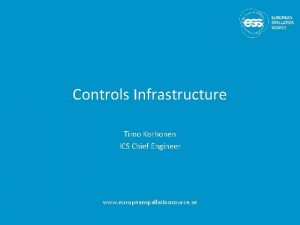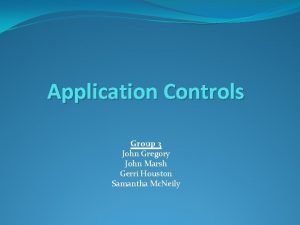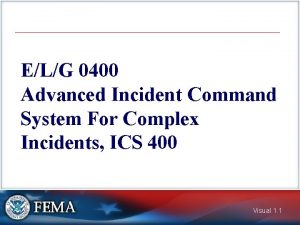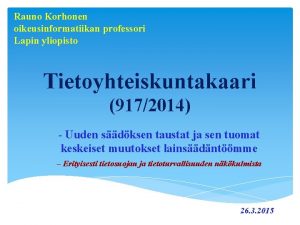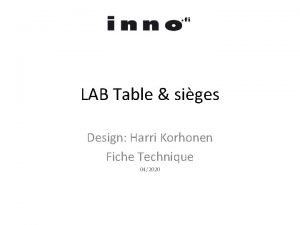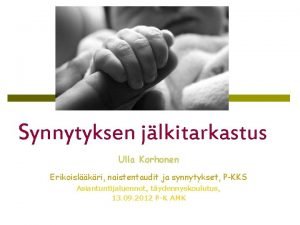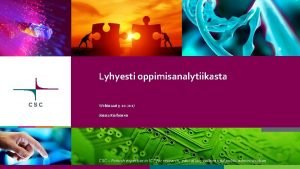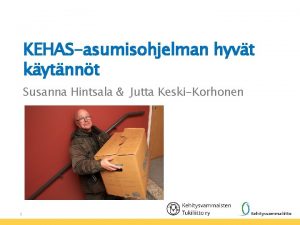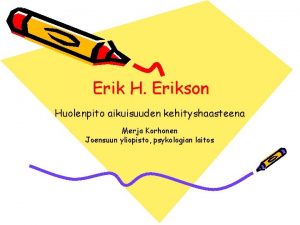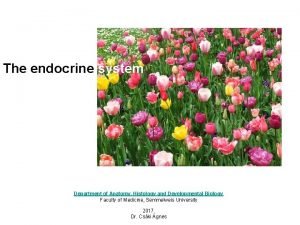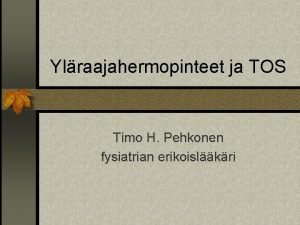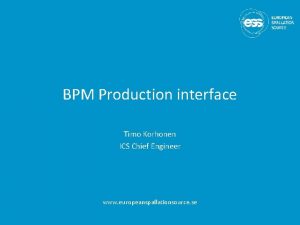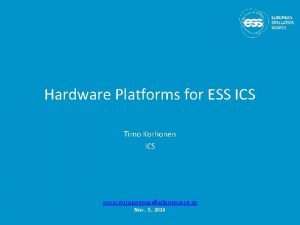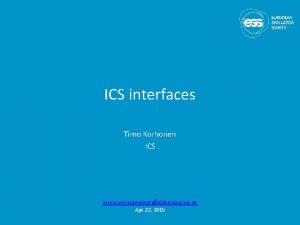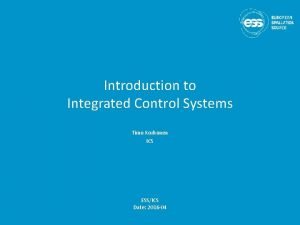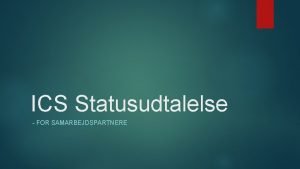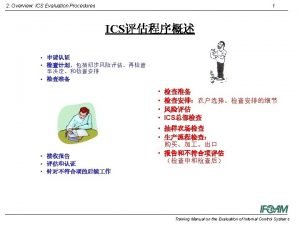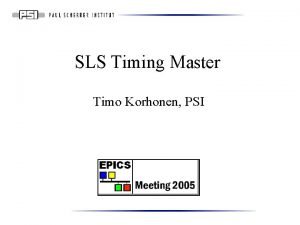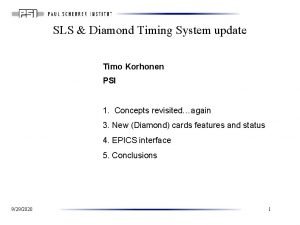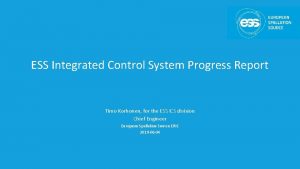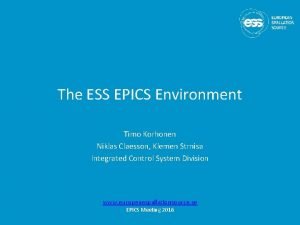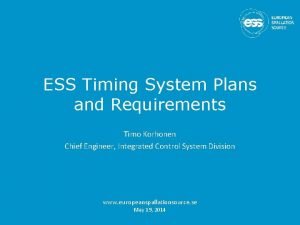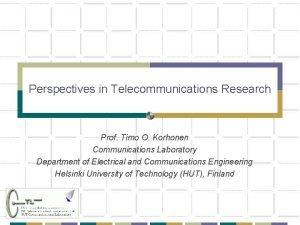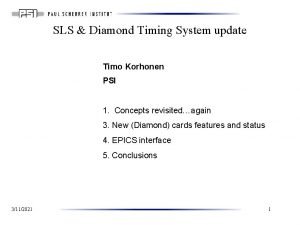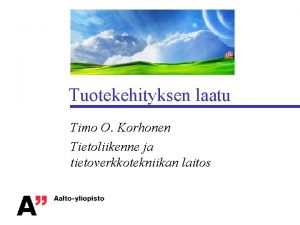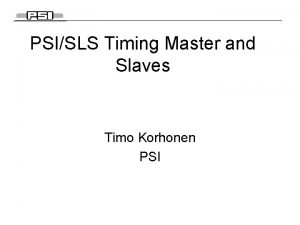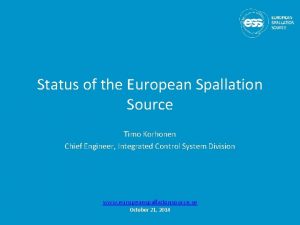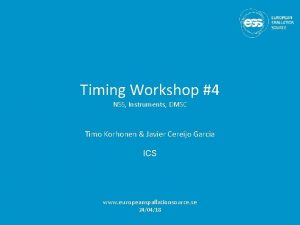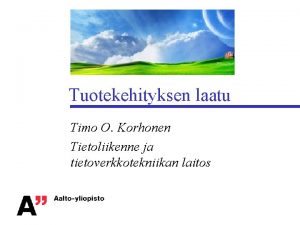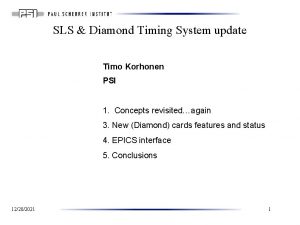RF Cell Controls Timo Korhonen ICS Chief Engineer






















- Slides: 22

RF Cell Controls Timo Korhonen ICS Chief Engineer www. europeanspallationsource. se

Overview • Overview of RF Cells • Accelerator control concept – Timing of the machine, mode information • Components – Status of ICS developments – Note: PSS and MPS handled in separate talks • Summary 2

Information source: RF Cell diagrams The diagrams provided by RF Group provide the (only available) overview of the systems • These are essential to understand the status of development 3

RF Cell setups in ICS understanding • LLRF, RF-LPS (local protection) in all cases • RFQ and DTL – Modulator, Klystron, (RFQ) tuning with water cooling loops • MEBT – Solid state amplifier, bunchers, no modulator • Spokes – RF power with solid state amplifiers, no klystron or modulator • Medium & High Beta – Modulator, Klystron (MB) or IOT (HB), cryomodules & SC cavities with slow and fast tuners • Walkthrough of integration status of each component 4

Components • • • LLRF Modulator Local Protection RF-LPS (and klystron control) Solid State Amplifier Circulator Control Unit Cryomodule Cavity Control Vacuum Control (ESS global vacuum controls) Master Oscillator, phase reference line 5

General tasks for ICS • Cell integration – Controls for each component (EPICS interfaces) – Global control of the whole cell • Timing system – Provided for the whole ESS (next slides) • Operating procedures – Start-up sequences (cell level integration) – global control interfaces (accelerator level) • Data handling – Archiving – Post-mortem • Conditioning procedures – Have not yet been talked about much – Require a lot of experience to program well – Manual conditioning out of question (I assume) 6

Timing and machine operation • Machine timing is one of ICS global services – Short recap of how it works – More details can be found in ESS-0088633 • Drives the operation of the machine – Close connection to MPS – Interfaces to many RF components, too. – Importance is often forgotten • More than a source of trigger pulses 7

Structure of the system 88 MHz RF Master Oscillator Master Event Generator fanout Event receiver • • Event receiver fanout Event receiver Master Event Generator (EVG) generates a continuous data stream (next slide) The (accelerator) synchronization frequency (of 88 MHz) will be fed into the master event generator and used as the system clock. Event receivers synchronize to that clock. The 14 Hz operating frequency will be generated by down conversion from RF in the event generator (divide 88. 0525 MHz by 6289464 to get 14. 00000064 Hz) All timing sequences, events, etc. , generated in hardware

Accelerator sequences 14 Hz <-> 71. 4 ms … t Beam Off, t=0+3395 us Beam On, t=0+535 us RF Pulse, t=0+530 us DATA Modulator, t=0+500 us • Transmit (well) before next cycle Pre-programmed sequences repeat at 14 Hz – Sequencer with a RF-synchronous 88 MHz clock (can be changed) – “programming” can happen in less than a millisecond • “Data”, i. e. , beam envelope mode, etc. , transmitted in parallel – Contains “plan” for the next cycle: envelope mode, beam/no beam, pulse counter, rep rate, … – Mode changes require a handshake with BIS • When mode change is transmitted, timing does not send beam before MPS/BIS gives OK 9

LLRF • MTCA-based system • Hosted in the same MTCA crate with RF-LPS (local protection) • Heavily dependent on timing (timing receiver in the same crate) • Hardware platforms Struck SIS 8300 -L 2 existing, SIS 8300 -KU new/enhanced version (WIP), future IFC 1420 (ICS standard platform, in-kind development) 10

LLRF integration status (ICS view) • Central control facilities in place – Development so far oriented for 704 MHz (cold linac) – EPICS interfaces exist, for cell operation • Discussion needed for – – – – Warm linac, special configurations (RFQ etc. ) Interfaces between LPS and LLRF (ICS-relevant ones) Tuner handling (motor, piezo; interface details unknown to ICS) Concept of machine operation, matching with mode handling, etc. “Pulse types” definition (machine level discussion) Beam current information to LLRF? Feedforwards, learning algorithms Archiving, alarms, debugging requirements, data synchronisation 11

Modulator • ESS development (SML) • First modulators in-kind from ESS Bilbao • Tendering process ongoing • No ICS interfacing done so far • Anticipating quite some work in this area • Good monitoring and system diagnostics would probably be useful • Strong dependence on timing 12

Modulator (SML) • Comments from the PDR (October ’ 16): – 1) The interface with ICS requirements needs to be finalized prior to release of the request for quote. This should include: HMI, and interlocks connection to the control system. Also the relevant portion of klystron protection shall be well described for the programmers. • Status: pending – 14) Consider increasing the sampling rate for the analog signal acquisition system. 100 k. Sa/s may alias important information that may compromise troubleshooting. Consider buffering data locally, storing data files locally after fault events and time-stamping fault events to aid in troubleshooting while equipment is in operation. • Status: no information – 19) Carefully monitor and manage the software development time schedule. • Status: (ICS) software development not started. Pending information. • Was briefly discussed but left pending the results of a tender (ESS Bilbao) – Quite some time has passed since…need urgently to get back to this 13

Local Protection (RF-LPS) • Working together with ICS – PLC part well advanced – Fast logic part making progress, slowly but surely • Start has been slow. • Closing to final specifications and implementation – Uses ICS standard platform – Proof-of-concept system, migration towards final MTCA in progress. • Clear interfaces to MPS • Issues to be clarified – Interoperation with LLRF – Developments with in-kind partners 14

Klystron (RFQ, DTL) • Controls of the klystron are handled in the RF-LPS system – – Solenoid power supply Filament heater Vacuum pumps Cooling • Blower • Water temperature, flow • Control system interface (EPICS) is working (in the lab) 15

Solid State Amplifier • Klystron pre-amplifier in RFQ, DTL – Procurement ongoing – Rough definition of interfaces • Ethernet-based • maybe SNMP, SCPI? – EPICS integration TBD • High power in MEBT – Details not known (to me) 16

Circulator control unit • Some initial ICS work done – Network interface – Signal list defined • Pending final hardware 17

Cavity control • • Work on RFQ controls starting In-kind with CEA (France) Details under discussion Experienced partner, established contacts with ICS 18

Cryomodule control • In-kind contribution by IPNO, France • Details becoming clear • EPICS integration by ICS • Integration to the cell control to be discussed 19

Master Oscillator, Phase reference line • Good communication with developers – Details to be clarified but no blocking issues (known). 20

Machine-level integration • To be discussed – not much has happened yet – How to present an integrated view • Interfaces with beam instrumentation – E. g. , beam phase measurement with BPMs – Feedforwards, role of beam current monitors • Control room operation – Startup – Data and control exchange with machine physics applications • Needs still many discussions – With ICS, RF, BI involvement – Please do not hesitate to contact us (ICS) 21

Summary • Overall picture starts to crystallize – Still a lot to do with all the interfaces and components – RF Cell block diagrams have clarified a lot – thank you! • Saved us a lot of time already • Most urgent issues to address (my view) – Modulator controls – Testing of RF-LPS • Confirm operation of prototype • Migrate to MTCA (work ongoing) – Integration of LLRF and RF-LPS • RF teststand 2 – Clarification of open issues in warm linac 22
 Mtca psu
Mtca psu Chief engineer of the union pacific railroad
Chief engineer of the union pacific railroad Chief engineer standing orders examples
Chief engineer standing orders examples Lesson 3 commander in chief and chief diplomat
Lesson 3 commander in chief and chief diplomat General controls vs application controls
General controls vs application controls He who controls the past controls the future
He who controls the past controls the future Advanced incident management system
Advanced incident management system Jenni korhonen
Jenni korhonen Rauno korhonen
Rauno korhonen Annikki korhonen
Annikki korhonen Korhonen courant
Korhonen courant Juha korhonen gynekologi
Juha korhonen gynekologi Jonna korhonen
Jonna korhonen Jonna korhonen okm
Jonna korhonen okm Kasperikoti rovaniemi
Kasperikoti rovaniemi Ella korhonen
Ella korhonen Eriksonin teoria
Eriksonin teoria Tamil nadu cm special cell
Tamil nadu cm special cell Zona glomerulosa produces
Zona glomerulosa produces Surfaces of thyroid gland
Surfaces of thyroid gland 3 parts of the cell theory
3 parts of the cell theory This organelle controls what enters and exits the cell. *
This organelle controls what enters and exits the cell. * Timo pehkonen
Timo pehkonen
